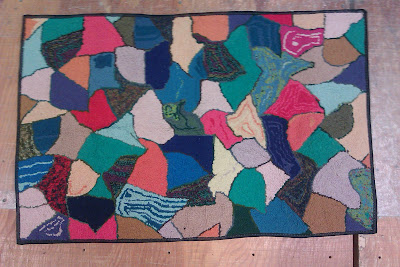Are you laughing like a school-grade aged child at the potential reference from the title? Good. Then my New Year's resolution of making one person smile or laugh per day is completed! However, this is serious business. I just finished working on a carpet base project of 1300 linear feet. Upon starting the project there were a couple of skips in the stitching. So, I started the regular procedure when this occurs:
- Check the threading path of the monofilament and nylon thread. Both were correctly threaded.
- Check the needle. Is it dull? Does it need to be changed? I replaced the needle.
Although it was a brand new needle, there were still skips in the stitching. At this point I'm beginning to get frustrated as well as perplexed.
What's the deal here? I thought. Then a light-bulb went on in my head.
The machine needs oil!
Lubricating oil is essential for the binding machines. In this case, the machine was well-oiled with the exception of this tiny triangular-shaped felt padding that is a key component to the threading path of the monofilament. Typically, before any project is started we put a few drops of oil onto the felt pad; which I had done upon starting this carpet base. Although, I was in a for a surprise because the felt pad was pretty dry, despite having put a few drops of oil in. I ended up putting in quite a bit of oil/lubricant onto the pad throughout the binding process. I was surprised at how much oil that little felt pad could hold!
In finishing up the project, I learned a valuable lesson- always check to make sure all parts and pieces are properly lubricated before, during and after a binding job. I could have wasted about 10 binding needles, assuming it was the needles (which is a typical issue), not the machine needing lubrication.
As they say, "You learn something new everyday."
In other news: Making the right call:
Let's talk about patterned carpet for a minute. We recently had a patterned carpet in here that needed to be cut and serged. It is always important to measure everything out first with patterned carpets, so that you can properly balance the pattern when cutting it. In this instance, Dan had drawn a line on the back of the carpet, which followed the straight-edge. Although it was a straight line, it was very obvious that the pattern of the carpet had been skewed upon the weaving process. At that point, we took pictures to send to our customer to ask how they wanted to proceed. The options were:
- Send the carpet back to the mill as defective.
- Cut the carpet to be square, regardless of the pattern.
- Cut the carpet to the pattern, ending with bowed sides.
- Power-stretch the carpet, in hopes to straighten out the pattern.
At first the customer told Dan, "Use your best judgement." Which just isn't sufficient. Dan's judgement is different than the buyer's judgement as well as their expectations. Dan was adamant that the buyer be informed of the issue and that our customer would instruct us accordingly.
Below you can see two pictures displaying a clear visual of how skewed the pattern of the carpet really was.
 |
| Visual showing the pattern skew versus the straight line. |
 |
| Visual showing the pattern skew versus the straight line. |
As you can see from the pictures, the pattern of the carpet runs off. I believe it went from 1/4 inch - 1 inch total. Typically the mills' instructions will have a 2 inch leeway before calling a carpet defective. Therefore, the first option of returning the product was no longer an option. Ultimately, the customer took the carpet back. Had an installer power-stretch it, stay-nail it into place and let it sit for 1 - 3 days. They also cut the carpet. This was a resolution that worked for this particular carpet. Power-stretching the carpet allowed for the carpet to be pattern balanced AND square. Although this is a good technique, it will not work with every carpet; depending on the backing of the carpet as well as the pattern/design.
This is one thing to keep in mind when purchasing patterned carpet. You may have to make the decision on whether to cut the piece square or cut it to the pattern. In some cases, you may have to wait an extra month or two, order a new piece and ship the existing piece back as defective. These are common issues that your sales rep. will help you with, if it should ever arise as an issue.
There is your carpet binding lessons for the day!
A big THANK YOU to everyone who has come into DWP Carpet Binding since the start of the New Year!












